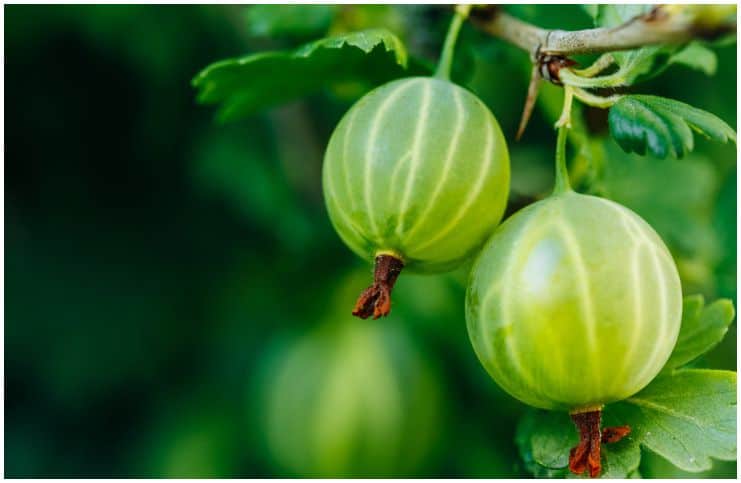Gooseberry (Amla) – Side Effects, Facts, Medicinal Uses, Health Benefits:
Facts
Gooseberry (botanical name – Phyllanthus Emblica), better known as Amla, from the Rosaceae family, is a highly branched shrub found in forests and bushes, from mountain regions to subalpine areas. It is sensitive to high heat and excessive cold.
It is native to Nepal and India, and that is the why main reason it is also known as the Indian Gooseberry. World production is 150 tons/year, of which 90% is in Europe. It is spread in Europe, Asia, North Africa, North, and Central America.
It has stems up to 1.5m high and gives a production of 3-5 kg per stem. Harvesting is done throughout the summer.
Chemical Composition
Fruits contain water (88-93%), protide (0.80%), malic acid, citric acid, tartaric acid (1.5%), fat (0.65%), sugar (8%), cellulose, vitamin C (26-34 mg%), vitamin A, vitamins B1 and B2, and K, P, Ca, Mg, Na, Zn, Fe, Cu salts. Energy: 48 kcal/100g, of which 89% is reabsorbed.
Health Benefits
Fruits are consumed as such (uncooked) or in the form of compote, jam, or juice.
Natural Remedy for UTIs
When consumed before meals, these fruits are tonic, and after meals, they are stomachic. The fruits are recommended for urinary tract inflammations, gravel, rheumatism, gout, obesity, and heart diseases.
They produce diuresis with the elimination of uric acid and urate. Also, they stimulate liver function.
Lowers Blood Sugar
Tea from this plant is ideal in the diet of people who suffer from diabetes, as it helps normalize blood sugar levels by stimulating insulin secretion.
They favor the formation of red blood cells, and a cure of these fruits is recommended for strengthening nails and sensitive teeth.
Cancer prevention
Vitamin C, also known as ascorbate and ascorbic acid, is a water-soluble vitamin that is required for numerous important body reactions.
For example, vitamin C selectively kills cancer cells – while leaving normal cells undamaged, according to a study done at the University of Iowa.
More importantly, this vitamin is needed by the body to produce tendons, skin, blood vessels, and ligaments, as well as to maintain and repair cartilage, teeth, and bones, and to form scar tissue.
More importantly, this vitamin is needed by the body to produce tendons, skin, blood vessels, and ligaments, as well as to maintain and repair cartilage, teeth, and bones, and to form scar tissue.
A deficiency of this vitamin may lead to the following symptoms – scaly, rough, or dry skin, dry hair, bruising, inflamed gums, frequent illnesses, slow-healing scrapes, cuts, or nosebleeds.
100g of these fruits contain 27,7mg of vitamin C which is 46 percent of the daily recommended value.
Improves Vision
Vitamin A is a group of antioxidant compounds that play an essential role in bone growth, vision, and the health of the immune system. Moreover, it helps in the development of the central nervous system and has a direct role in performing physiological functions.
Other functions of this vitamin include the maintenance and formation of soft tissue, teeth, and mucous membranes. A deficiency of this vitamin may lead to a thickening of the cornea, which eventually can lead to blindness.
100g of these fruits contain 290 IU of vitamin A, which is 6 percent of the daily recommended value.
Heart Disease Protection
Fiber, also known as roughage, is the part of plant-based foods (fruits, grains, nuts, seeds, vegetables, and legumes) that your body can’t break down. Dietary fiber lowers the risk of constipation by softening and bulking up your stool.
According to a review of 22 studies issued in the BMJ, for every seven grams of dietary fiber consumed per day, your risk of heart disease drops by nine percent.
100g of these fruits contain 4,3g of fiber, which is 17 percent of the daily recommended value.
Improves Strength
Potassium is one of the 7 essential macro minerals, along with magnesium, calcium, sodium, phosphorus, sulfur, and chloride. One of the benefits of consuming foods rich in this mineral is improved muscle strength and decreased muscle cramping.
100g of these fruits contain 198 mg of potassium which is 6 percent of the daily recommended value.
Good for Children
Due to their very rich content of vitamins and minerals, they are recommended in the diets of children, and considered to be the summer fruits of the mountains.
They are also recommended for children over 1 year old or after their diet has already been diversified, due to their high content of vitamins. Their introduction in the diet should be done with caution, because of their high content of citric acid and the risk of choking. It is also recommended to consult your pediatrician.
Side Effects of Gooseberry (Amla)
- It’s possible to interact with antibiotics and anticoagulants, therefore it is recommended to avoid eating them if you are taking this type of medication.
- Pregnant women should consume these plants with caution, as they can cause problems in pregnancy.
- It is also contraindicated in case of allergies to these fruits.
READ THIS NEXT:
Cornflower (Centaurea Cyanus) – Facts
Hazel (Corylus Avellana) – Facts
Pickled Mustard Seeds (Black, Brown, Yellow) – Side Effects
Pokeberry (Pokeweed or Phytolacca Americana) – Side Effects
References https://www.ncbi.nlm.nih.gov/pmc/articles/PMC3326920/ https://www.ncbi.nlm.nih.gov/pubmed/21317655
